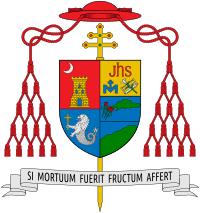Gaudencio Rosales facts for kids
Quick facts for kids Gaudencio Borbón Rosales D.D. |
|
|---|---|
| 'Cardinal Archbishop Emeritus of Manila' |
|

Cardinal Gaudencio Rosales, around 2006
|
|
| Province | Manila |
| See | Manila |
| Appointed | September 15, 2003 |
| Enthroned | November 21, 2003 |
| Predecessor | Jaime Sin |
| Successor | Luis Antonio Tagle |
| Other posts |
|
| Orders | |
| Ordination | March 23, 1958 |
| Consecration | October 28, 1974 by Bruno Torpigliani |
| Created Cardinal | March 24, 2006 |
| Rank | Cardinal-Priest |
| Personal details | |
| Born | August 10, 1932 Batangas, Philippine Islands |
| Nationality | Filipino |
| Denomination | Roman Catholic |
| Residence | St. Francis de Sales Theology Seminary, Lipa City, Batangas |
| Previous post |
|
| Alma mater | San Jose Seminary |
| Motto | Si mortuum fuerit, fructum affert ('If it dies, it bears fruit.', John 12:24) |
| Coat of arms |  |
| Styles of Gaudencio B. Cardinal Rosales |
|
|---|---|
 |
|
| Reference style | His Eminence |
| Spoken style | Your Eminence |
| Informal style | Cardinal |
| See | Manila (Emeritus) |
Gaudencio Borbón Rosales (born August 10, 1932), also known as Lolo Dency, is a high-ranking leader in the Filipino Catholic Church. He served as the Archbishop of Manila from 2003 to 2011. In 2006, he was made a cardinal, one of the highest honors for a priest.
Rosales was the fourth Filipino to become the Archbishop of Manila. Near the end of his time as archbishop, he also took charge of the Diocese of Pasig for about six months. He is also the longest-lived Filipino cardinal, having lived longer than Cardinal Jose Tomas Sanchez.
Contents
Early Life and Path to Priesthood
Gaudencio Rosales was born in Batangas, in the province of Batangas. His family was well-known in the area. His grandfather, Julián Rosales, was a mayor, and his other grandfather, Pablo Borbón, was a governor. His father, Dr. Godofredo Dilay Rosales, was a doctor who studied in the United States of America.
Even as a young boy, Rosales knew he wanted to be a priest. He went to Batangas Elementary School and St. Bridget's Grade School. For high school, he attended Batangas High School. Later, he studied religion and philosophy at the San José Seminary. On March 23, 1958, he officially became a priest.
After becoming a priest, he taught for 12 years at a seminary in the Diocese of Lipa. In 1970, he was put in charge of his first parish, St. Vincent Ferrer Parish in Lipa. Two years later, he became the priest of the Immaculate Conception Parish in Batangas City.
Becoming a Bishop
In 1974, Rosales was chosen to be an auxiliary bishop of Manila. This made him the first person from Batangas to hold that position. An auxiliary bishop helps the main archbishop run a large church district, called an archdiocese. He was officially made a bishop on October 28, 1974.
In 1980, he became the head of San Carlos Seminary, a school for training new priests. Two years later, he was sent to Bukidnon to help the bishop there. In 1984, he became the second bishop of the Diocese of Malaybalay.
Archbishop of Lipa and Manila
On December 30, 1992, Rosales was appointed the new Archbishop of Lipa. This brought him back to the diocese where he first started his work as a priest.
When Cardinal Jaime Sin, the Archbishop of Manila, retired, Pope John Paul II chose Rosales to take his place on September 15, 2003. He was officially installed as the new Archbishop of Manila on November 21, 2003.
Becoming a Cardinal
On February 22, 2006, it was announced that Rosales would become a cardinal. A cardinal is a leading bishop and a close advisor to the Pope. Pope Benedict XVI officially made Rosales a cardinal on March 24, 2006, in a special ceremony called a consistory. He was given the title of Cardinal-Priest of Santissimo Nome di Maria in Via Latina.
Pope Benedict XVI told the new cardinals that their red robes stood for caritas, a Latin word for love and charity. He said, "May the scarlet that you now wear always express the caritas Christi, inspiring you to a passionate love for Christ, for his Church and for all humanity."
In 2007, Rosales was appointed to a special group of 15 cardinals who help manage the business and financial side of the Catholic Church's headquarters in Rome.
When he turned 75 in 2008, Rosales offered to retire as archbishop, as all bishops are required to do. However, the Pope did not accept his resignation at that time. He continued to serve as Archbishop of Manila until he was 79. He was succeeded by Luis Antonio Tagle on December 12, 2011.
After turning 80 in 2012, he was no longer able to vote in a papal conclave, the meeting where a new Pope is elected. On August 10, 2024, he celebrated his 92nd birthday, becoming the longest-living Filipino Cardinal.
Views on Government
Archbishop Rosales believed that the country's constitution could be improved. However, he warned politicians not to make changes just to help themselves. During a time of national emergency in the Philippines, he asked people to pray for peace. He also hoped the government would respect the rights of its citizens.
See also
 In Spanish: Gaudencio Rosales para niños
In Spanish: Gaudencio Rosales para niños

